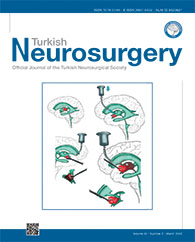2Gaziantep University, School of Medicine, Department of Neurology, Gaziantep, Turkey
3University of Health Sciences, Gulhane School of Medicine, Department of Neurosurgery, Ankara, Turkey DOI : 10.5137/1019-5149.JTN.35124-21.1 AIM: To present a series of hydrocephalus cases treated with different endoscopic techniques, and to compare their surgical outcomes.
MATERIAL and METHODS: Sixty-one patients underwent endoscopic approach for treating hydrocephalus over a 5-year period. Forty-six patients were children. Three surgical techniques [i.e., endoscopic third ventriculostomy (ETV), ETV plus shunting, and simultaneous ETV plus aqueductoplasty] were used in these patients. Surgical results were statistically analyzed based on age, gender, and type of surgery.
RESULTS: Of the 46 children, 24 (52.17%) were female with a mean age of 25.33 months. Twenty-one (45.65%) children underwent ETV alone, 19 underwent ETV plus ventriculoperitoneal shunting, and six underwent simultaneous ETV plus aqueductoplasty. Five (10.87%) children died during the follow-up period. No correlation was observed between surgery type and patient age. No statistically significant differences in sex and complications were found between the surgical techniques.
CONCLUSION: ETV alone is the safest method for treating hydrocephalus in children. Mortality is higher in patients younger than 12 months who underwent combined surgical methods, instead of ETV alone.
Keywords : Hydrocephalus, Children, Endoscopic third ventriculostomy, Shunt, Aqueductoplasty




